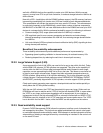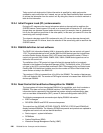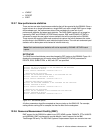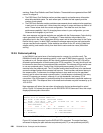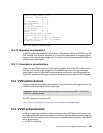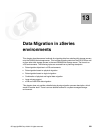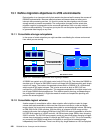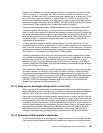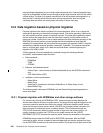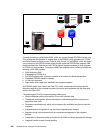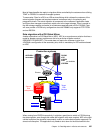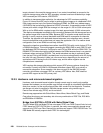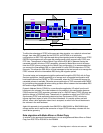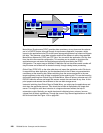Chapter 13. Data Migration in zSeries environments 253
8-packs. The allocation of a volume happens in extents or increments of the size of an IBM
3390-1 volume, or 1,113 cylinders. So a 3390-3 consists of exactly three extents from an
extent pool. A 3390-9 with 10,017 cylinders comprises 9 extents out of an extent pool. There
is no affinity any longer to an 8-pack for a logical volume like a 3390-3 or any other sized
3390 volume. Despite the fact that it is not required any longer to move from a 3390-3 volume
type to some bigger volume type with the DS6800, you might consider planning such a move
in the course of a data migration effort to reduce the number of volumes.
Although with the newly announced DS6800 storage servers we now support logical 3390
volumes of up to 65,520 cylinders, you might still plan for a standard sized logical volume,
which is smaller than volumes as big as the new maximum volume size allows. Consider that
full volume operations will take longer to copy or dump when increasing the volume size. This
also applies to the first full initial volume replication for Metro Mirror when creating the pairs,
as well as for XRC. A compromise has to be planned for, which might be different from
configuration to configuration.
In a pure system-managed storage environment with no full volume operations any more,
except for migration perhaps, a volume size of 30,051 cylinders might be fine for most of the
data. This is the space of nine 3390-3 volumes or 27 extents out of an extent pool. This would
guarantee that all space is fully utilized when staying with increments of the standard extent
size, which is 1,113 cylinders or the equivalent of a 3390-1 model.
Utilizing big volumes will require the use of dynamic parallel access volumes (PAV) to allow
many concurrent accesses to the very same volume. On such a big volume we see about 9
times as many concurrent I/Os than what we might see on a single 3390-3. Or to put it
differently, we see on a single volume as many concurrent I/Os as we see on nine 3390-3
volumes. Despite the PAV support it still might be necessary to balance disk storage activities
across disk storage server images.
With installations still performing full volume operations to a significant extent you might plan
for smaller volumes. For example, to fully dump nine 3390-3 volumes in parallel will most
likely have a shorter elapsed time than dumping a single volume with the capacity of nine
3390-3 volumes. In such an environment a classical 3390-9 volume might still be appropriate.
Although a 3390-9 volume has three times the capacity of a 3390-3, when changing from
ESCON to FICON, the throughput increases roughly by a factor of 10 and shortens the
elapsed time, especially for highly sequential I/O.
13.1.3 Keep source and target volume at the current size
When the number of volumes does not reach the current z/Series limit of 64K volumes or is
significantly below this limit, you might stay with 3390-3 as a standard and avoid the additional
migration effort at this time. Volume consolidation is still a bit painful because it requires
logical data set movement to properly maintain catalog entries for most of the data. Only the
first volume can be copied through a full volume operation to a larger target volume. After that
full copy operation, the VTOC on the target volume needs to be adjusted to hold many more
entries than the first source volume. Another consideration for the first full volume operation is
that the volume names must be maintained on the new volume, because full physical volume
operations do not maintain catalog entries. Otherwise you would not be able to locate the
data sets any more in a system-managed environment, which always goes through the
catalog to locate data sets and orients data set location solely on volume serial numbers.
13.1.4 Summary of data migration objectives
To summarize the objective of data migration, it might be feasible to not just migrate the data
from existing storage subsystems to the new storage server images, but also to consolidate



